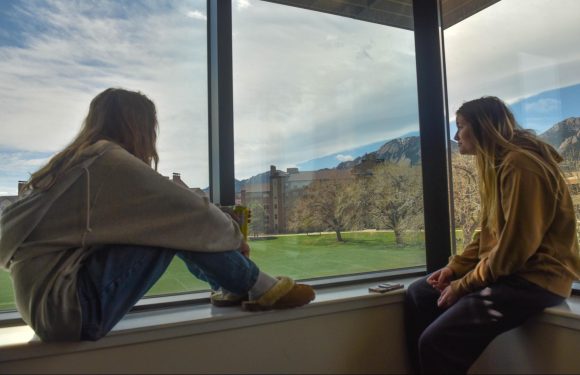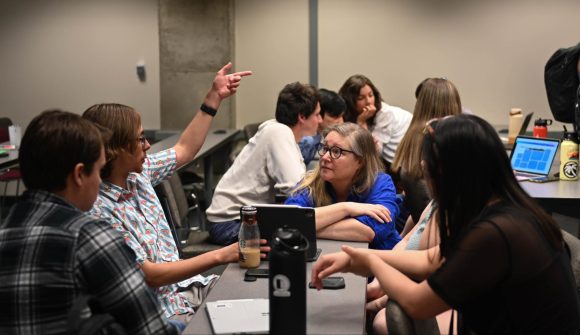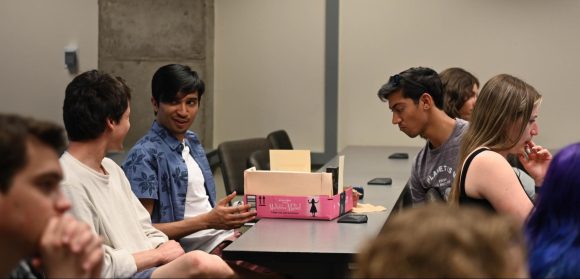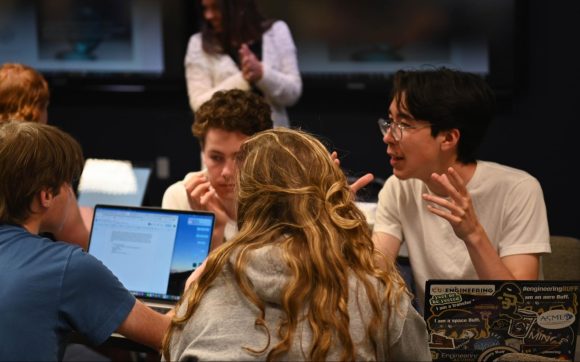
Ali Bajaj and Lauren Mooney discuss how they came to terms with living in a commonly stigmatized area of campus on April 27, 2023. They both said finding their own communities in Williams Village aided tremendously with their appreciation for the area. “Will Vill feels like a jail sentence, and then you make a community in your jail,” Mooney said. (Grace Ptak/CU Independent)
“It would be so beautiful without those ugly-ass towers,” asserted Lauren Mooney, sitting on a window ledge and staring out at the brown, boxlike Darley Towers blocking the view of the Boulder Flatirons beyond them.
Mooney, a freshman at the University of Colorado Boulder, was assigned to a dorm in Williams Village, a student housing area isolated from the main campus not only physically, but socially. The distance and mystery of the area have saddled Williams Village with its very own campus-wide reputation.
“Whenever I tell people I live in Will Vill, they’re like, ‘Oh, you’re one of those,’” Mooney said.
Ali Bajaj, Mooney’s close friend, nodded in response. The pair overlooked a sprawling grass field surrounded by blocky buildings on each side, people-watching from the Williams Village North building on the sunny spring day.
“I had an advantage because I already had friends here when I was moving in,” Bajaj said. “If one of [my friends] lived on main, I know we wouldn’t be as close.”
As the 2022-23 academic year came to a close, students and faculty at CU Boulder were preparing for an immense student housing shift. In fall 2023, all incoming freshman engineering students are required to live in Williams Village for the foreseeable future in a residential community called ‘Engineering Connections,’ with limited options to live on the main campus. The problems and potential of Williams Village are back at the forefront of the university’s collective consciousness, and several faculty and staff saw an opportunity to change the culture there for the benefit of the incoming engineers.
Located about a mile from main campus, Williams Village is home to multiple student housing buildings– the Stearns and Darley Towers, Williams Village North and Williams Village East– as well as a dining hall and recreation center. A student traveling from one of these halls to a class in the Engineering Center faces either a half-hour walk along a major road or a 15-minute trip by bus, contributing to the area’s isolated feel.
The decision to move freshman engineers to Williams Village was met with some backlash from the community, a petition with nearly 500 signatures created by a former CU Boulder chemical engineering student and disagreement from some current CU Boulder engineering students across campus.
While unpopular, CU Boulder chose to condense the engineering students into a single residence district not because the engineering culture is undesirable in its current locations, but because academic and social resources will ideally be more easily accessible to these students when they’re housed closer together.
In order to guarantee that student voices are heard in the moving process, a unique engineering leadership class called ‘Leading Emergent Communities’ was created for the 2023 spring semester, spearheaded by engineering-adjacent professors Diane Sieber, Angela Thieman-Dino and Scot Douglass — the faculty director of the new Engineering Connections community. Students participating in the class study psychology, urban design and community building, and have submitted proposals for change in and around Williams Village in hopes of making the dorms more welcoming and supportive. The common vision among those students is for Williams Village to become a more comfortable space with a vibrant community rather than an isolated housing area.
“[Williams Village] kind of has a reputation, and we should have dealt with that reputation a long time ago,” said Miriam Nieberg, a mechanical engineering major enrolled in the class. “But now that we’re making such a major change and moving all of the engineers there, it’s a good opportunity to make those necessary changes to get rid of that stigma.”
The goal of the class is not strictly to beautify the area, but also to learn how an intentionally designed space can correlate to creating a community. According to Douglass, any extraneous conference room can be made into a makerspace, a video game lounge or a mini self-serving cafe in order to foster connections.
The move to Williams Village is a unique opportunity to put these principles into practice, as an entirely new incoming class creates an opportunity to cultivate the community these students want to see.
“[The class] is an experiment in student participation; in creating a community in a way that’s real, and that is taken seriously and therefore impactful,” said Thieman-Dino, a cultural anthropologist and associate professor in the engineering department. “How do we build things that are meaningful… and yet, also adaptive and flexible and improvisational in the ways that… communities have to be in order to sustain themselves?”

Diane Sieber sits with a transportation-focused group on April 11, 2023. The group discusses their project logistics with her, looking for professor approval and confirmation that their proposed plan could one day be executed. (Grace Ptak/CU Independent)
During spring finals week at CU Boulder, groups of students from the class presented their ideas to university staff who are involved in the move to Williams Village and have the funds to make the students’ visions a reality.
“My goal [for this class is] that it ends with an incredibly cool display of student work… and I think [it will] provide this sort of spectrum of possibility for how [to] communicate a great idea,” said Sieber, an associate professor involved in the Herbst Program for Engineering, Ethics and Society. “I think all of these different stakeholders are much more likely to have an open mind if they know that this came from students.”
When dealing with projects on a scale of this size, there will always be an element of doubt.
Having never taught a class exactly like this one, Sieber made her own prototype for class– a dark academia themed library space with tall bookshelves and enough room to host her own class within next fall. Her confidence in her students’ ideas is clear, but she wanted to make sure she’d be able to help them pitch their visions properly.
“I wanted to be sure that I was trying to do this alongside students because I’d never assigned students to do something like this before,” Sieber said. “Then I would see what the obstacles are.”
“I really enjoy that the university is open to having a class like this,” Nieberg said. “Something that I found myself saying a lot in my freshman year is that we are one of the best engineering schools in the country – why is our campus so poorly designed? We have these great engineering students, letting them engineer what they need is a brilliant idea.”
Despite best efforts, doubts remain
Despite their confidence with the tools they’ve been given throughout the course of the class, doubts about the move to Williams Village are inevitable. Some students fear the change the new environment will bring and worry that their contributions to the area’s culture won’t be enough to make life easier for this year’s freshman engineers.
“Something that I find rather interesting about this class is how few of us have actually lived there. And so it’s weird for us to be like, ‘I know what’s best for you,’” said Chris Brown, a mechanical engineering student enrolled in the class. “There are groups trying to clean up transportation, or trying to look at class systems. You wonder how much power they have.”
Under half of the people in the class have lived in Williams Village. Most of the students lived in Kittredge Central or buildings surrounding the ‘engineering quad’ on main campus, and are worried that the culture centered around those areas won’t be able to transfer to the new engineering hub next year.
“Everyone who’s had a positive experience understandably fears that [experience] being lost for future people,” Thieman-Dino said of the previous engineering housing spaces. “I think that makes a lot of sense that people would be worried about losing [what] was valuable about their own experience.”
Thieman-Dino’s approach to alleviating that fear is to discuss what exactly students will miss about those areas.
The academic shift for engineers from high school to college, coupled with intimidating stories about the difficulties of certain classes or exams coming from older students, can create a very tense social environment for freshman engineering students. Relaxing social events that would normally help with these students’ stress can easily get put on the back burner due to the sheer demand of their academic responsibilities.
“I think that having people who are [willing] to be honest that they didn’t know [what to do] was really helpful psychologically. I knew I wasn’t the stupidest person there,” said Sydnei Lewis, a senior biomedical engineering major and recitation leader for the Engineering Honors Program (EHP). “Having people in the trenches with you who have a good attitude and who are helpful, and also being that to other people… really, really helped.”
According to Thieman-Dino, one of the class’ main goals is to continue the tradition of engineering camaraderie.
“It’s not like life stops being stressful after you graduate from college,” Thieman-Dino said. “Figuring out how to be a healthy person in a community with others in circumstances that challenge us cognitively and emotionally, ethically and socially [is] probably the most important thing they’ll learn in college.”

A class group examines Sieber’s prototype and discusses how their own model will eventually look on April 11, 2023. (Grace Ptak/CU Independent)
RAP programs offer safe spaces for minority engineering students
For those who feel isolated from peers who share their identities, finding a meaningful community within engineering can be difficult.
To help freshman engineers under pressure find their communities, Residential Academic Programs or Living Learning Communities within engineering, like Global Engineering or the Engineering Honors Program, can help.
In the new Williams Village community, every student will be required to join a RAP– a general engineering RAP will act as a catch-all for those who do not opt to join a specialty program like Global Engineering or EHP. In previous years, only 62% of engineering students participated in these experiences.
According to Nieberg, membership in these communities is instrumental in building relationships. They provide opportunities for students to mentor and interact with each other, and can offer a home to students who may not traditionally feel like they belong in the major.
“It definitely felt like there were more queer people, more women, more people of color in Global compared to every class I’ve had that was just general engineers,” Nieberg said. “That’s really helped in feeling a sense of inclusion in being an engineer that I have heard a lot of the people who aren’t in these groups lack.”
According to the CU Boulder Undergraduate Retention and Graduation Rates study, only 40% of the College of Engineering consisted of female students in 2022, and only 36% were students of color. For people who are part of a minority group, camaraderie with peers in their community can be an essential step towards feeling welcome in their major.
“I personally know several minority engineers who dropped out,” said Nieberg. “They were like, ‘I didn’t feel accepted in engineering. The workload was too hard. I didn’t have a support network.’”
In the past, the RAP and LLC communities’ advertising fell short according to Lewis, and some freshmen who could have benefitted from those communities just didn’t know about them. Because all freshman engineers will be living in such close proximity in Williams Village, that outreach issue will likely improve. While all freshman engineers will automatically join a general engineering RAP in Williams Village, it will still be the student’s responsibility to take the steps necessary to instead join specialty programs like Global Engineering or EHP.
“I think it is cool to have all of the engineers together,” said Lewis. “I think you will get exposed to other people, but that also sort of calls into attention that you have to seek [those communities] out.”

Chris Brown (right) leads his group’s discussion on April 11, 2023. He aspires to create a maker-space within Williams Village that could act as a craft room and engineering prototyping space all in one. (Grace Ptak/CU Independent)
Still, the new community in Williams Village won’t be able to fix every issue –– and many of the problems also exist in other dorms and majors.
“A lot of my aspirations for what Williams Village could be [are] rooted [not in] critiques of Williams Village itself, but just seeing the opportunity for all students to be able to experience what, currently, only some students get to experience in terms of having a place that feels like a home,” Thieman-Dino said.
“How could we not try to provide for everyone what we know has been possible for many?” she added.
As for what’s next, preparations are well underway to welcome the first round of students to Engineering Connections in the fall. Despite the tireless dedication and design of engineering professors, students and faculty alike in ensuring this project is a success, skepticism among the student population will inevitably remain.
“If I were an engineering student and I opened the [housing] portal and could only choose Will Vill, I would be angry,” said Bajaj.
“It just feels like they’re condemned to Will Vill,” said Mooney.
Williams Village carries with it a stigma of isolation, and it may take some time for the culture and reputation of the area to meaningfully shift. The class and its professors understood that the project would be surprising to the existing community, and were careful to identify any inherent dangers or concerns that skeptical students might have and keep them in the forefront of their planning.
“Sometimes aspiring to truly transformative change seems so hope-full that people assume these communities are just ignoring or dismissing risks — but to the contrary, these communities are especially eager to understand risks and dangers because they know this understanding is essential to achieving their visions in ways that align with their values. Arguably, the most effective changemakers are even more attuned to dangers than their critics!” wrote Thieman-Dino in an email.
Beginning on Aug. 20, the very first students in the Engineering Connections community moved into Williams Village. Because of Leading Emergent Communities, they will be handed the reins of a culture that students in the years above them personally helped to design, and in a year, will make of it what they can.
Contact CU Independent Guest Writer Grace Ptak at Grace.Ptak@colorado.edu
